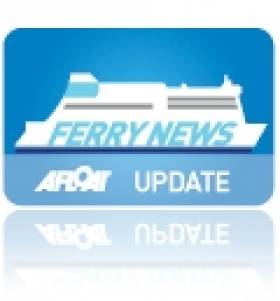Displaying items by tag: New FrenchSpain routes
Continental Rosslare Routes Ro-Pax Rivals Meet for First Time
#IrelandFranceSpain – Newcomer LD Lines ro-pax Scintu, to be renamed Norman Atlantic, met one of her rivals operating on continental routes when Irish Ferries Cartour Epsilon docked in Rosslare Europort yesterday, writes Jehan Ashmore.
As previously reported, LD Lines inaugural inbound sailing from France to Ireland took place with a Thursday night arrival at the Wexford port. The 26,904 tonnes ferry remained in port overnight and for much of yesterday prior to setting sail last night on the first outward sailing of the Rosslare-St.Nazaire-Gijón service.
The first leg of the Ireland-France-Spain service sees Scintu scheduled to arrive in St.Nazaire at 19.00hrs this evening.
Irish Ferries ro-pax Cartour Epsilon which initially entered service on the Dublin-Holyhead route just before the busy festive season saw the ferry only make a handful of sailings due to the low level of sailings assigned to the newcomer.
In addition a spate of bad weather led to cancelled sailings of the Cartour Epsilon including fast-craft Jonathan Swift sailings, leaving flagship Ulysses on occasions to operate crossings alone.
As also reported on Afloat.ie, Irish Ferries are to operate the 2011 Visentini shipyard built Cartour Epsilon (same design of Scintu, built 2009) on Dublin-Holyhead route in addition on the new Dublin-Cherbourg route starting this day next week (18 January).
In the meantime Cartour Epsilon is currently providing relief cover on the Rosslare-Cherbourg route in place of cruiseferry Oscar Wilde which transferred to sailings between Rosslare-Pembroke Dock.
Oscar Wilde displaced the Welsh route ferry Isle of Inishmore which in turn took over the sailing roster of Cartour Epsilon on the Dublin-Holyhead route also during the run up to the festive period.
Rival ro-pax continental ferries, Scintu (on left) berthed adjacent to Cartour Epsilon yesterday at Rosslare Europort. Photo: Jehan Ashmore
Isle of Inishmore subsequently took over the sailing roster of Ulysses which is undergoing annual maintenance at Cammell Laird, Birkenhead. In the meantime partnering Isle of Inishmore on the Dublin-Holyhead route is the fast-ferry Jonathan Swift.































































